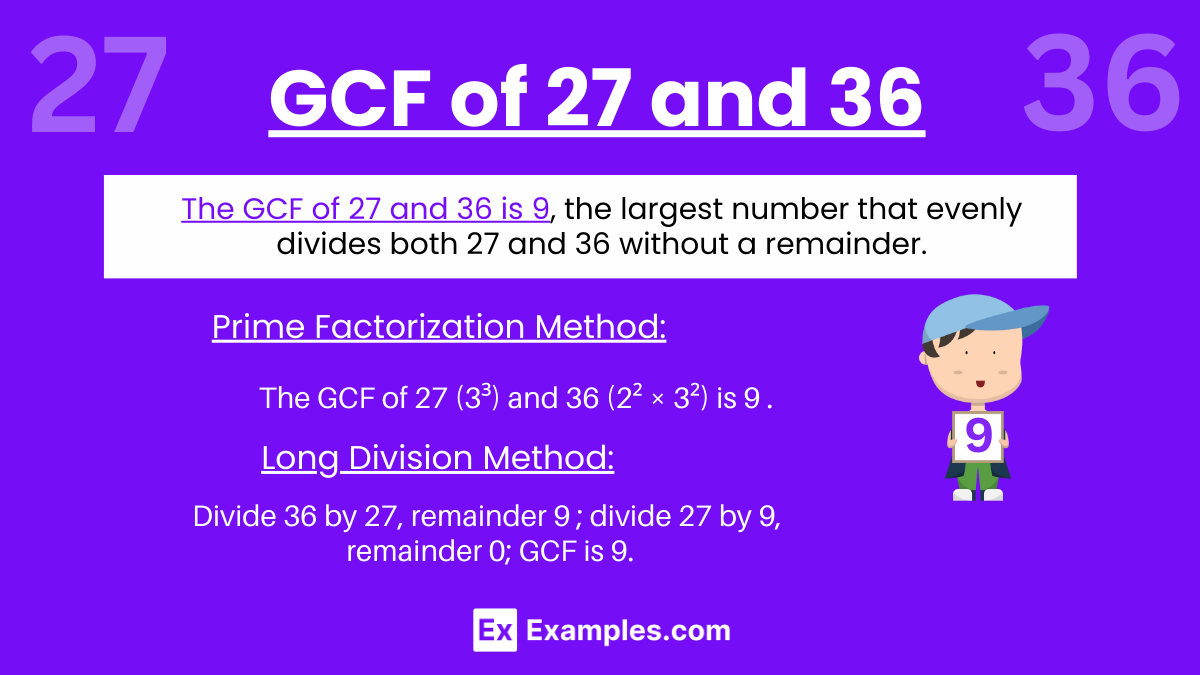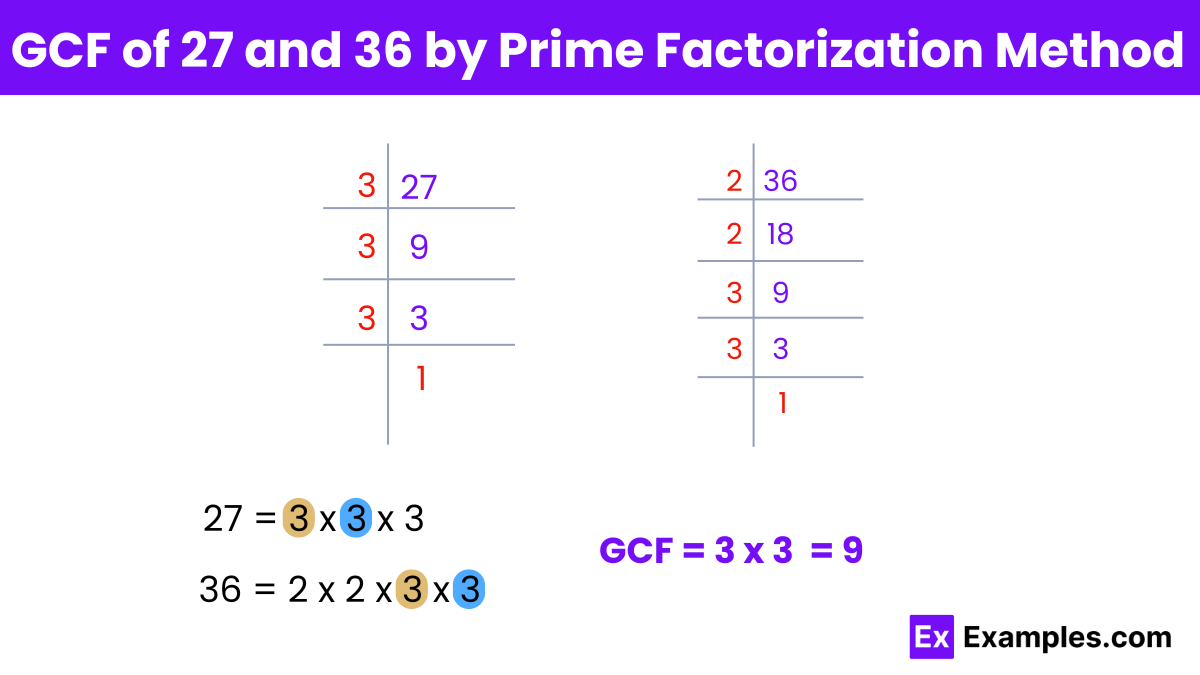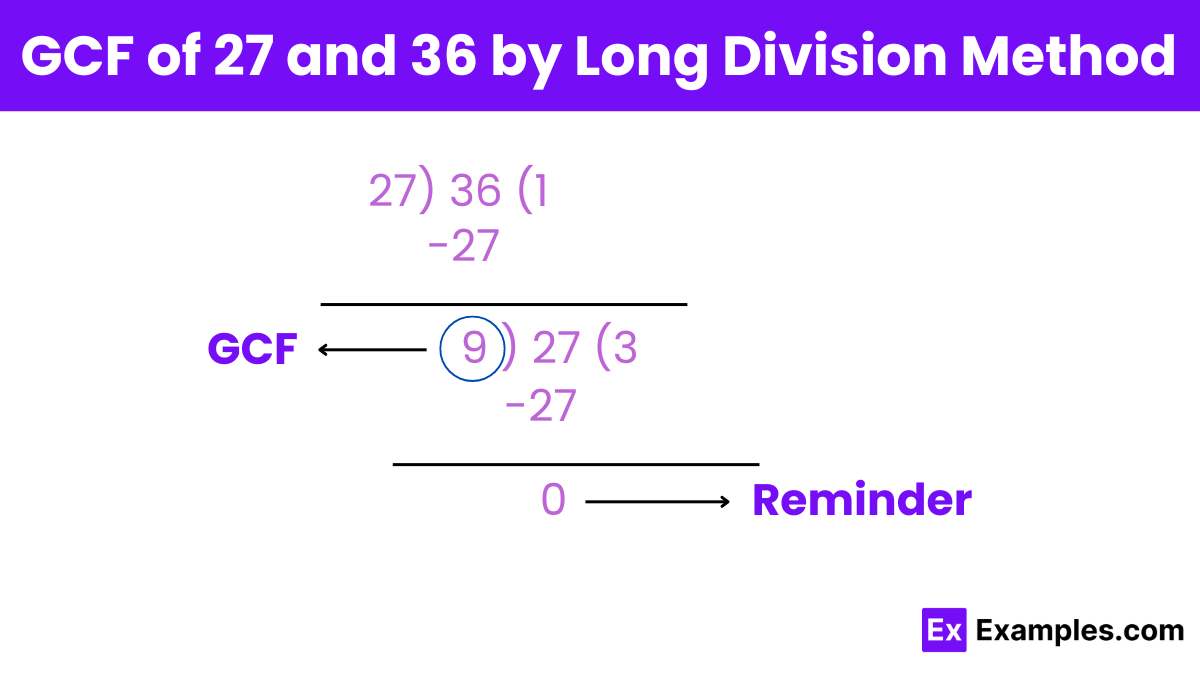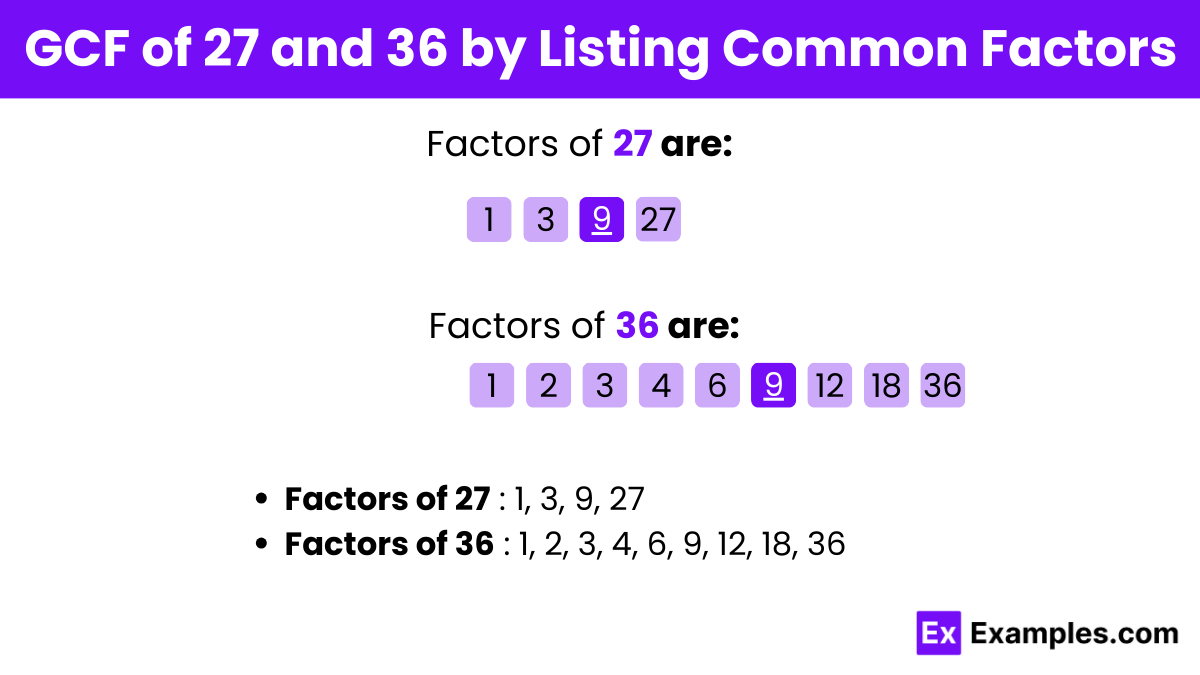What is the Greatest Common Factor (GCF) of 27 and 36?
3
6
9
12


The greatest common factor (GCF) of 27 and 36 is 9. This value can be determined through various methods such as prime factorization, long division, or listing common factors. By prime factorization, 27 breaks down to 3³ and 36 to 2²×3². Both numbers share the prime factor 3, and the lowest exponent of 3 common to both is 3², hence the GCF is 9. Alternatively, by listing factors, the common factors of 27 (1, 3, 9, 27) and 36 (1, 2, 3, 4, 6, 9, 12, 18, 36) reveal that 9 is the largest number both share. The long division method also leads to the same result, confirming that the GCF of 27 and 36 is indeed 9.

To find the greatest common factor (GCF) of 27 and 36 using the prime factorization method:
Step 1: Prime factorize both numbers:
For 27: 27=3³
For 36: 36=2² × 3²
Step 2: Identify the common prime factors and their lowest powers:
Step 3: Multiply the common prime factors with their lowest powers:
GCF = 3² =9
Therefore, the greatest common factor (GCF) of 27 and 36 by prime factorization method is 9.

To find the greatest common factor (GCF) of 27 and 36 using the long division method:
Step 1: Start by dividing the larger number (36) by the smaller number (27).
36 ÷ 27 =1 with a remainder of 9.
Step 2: Then, take the divisor (27) and divide it by the remainder (9).
27 ÷ 9 = 3 with a remainder of 0.
Since the remainder is now 0, the division process stops here.
Step 3: The divisors at this step where the remainder becomes zero is the greatest common factor (GCF).
GCF = 9.
Therefore, the greatest common factor (GCF) of 27 and 36 by the long division method is 9.

To find the greatest common factor (GCF) of 27 and 36 by listing common factors:
Step 1: List the factors of each number.
Factors of 27: 1, 3, 9, 27
Factors of 36: 1, 2, 3, 4, 6, 9, 12, 18, 36
Step 2: Identify the common factors.
Step 3: Determine the greatest common factor.
GCF = 9.
Therefore, the greatest common factor (GCF) of 27 and 36 by listing common factors is 9.
The Euclidean algorithm, often implemented through long division, can efficiently find the GCF.
It aids in simplifying expressions and solving problems involving ratios and proportions.
It breaks down numbers into their building blocks, revealing common factors.
No, the GCF should be the same regardless of the method used.
Frequently in areas like engineering, computing, and when working with proportions.
Yes, using Venn diagrams with prime factor circles can visually represent common factors.

The greatest common factor (GCF) of 27 and 36 is 9. This value can be determined through various methods such as prime factorization, long division, or listing common factors. By prime factorization, 27 breaks down to 3³ and 36 to 2²×3². Both numbers share the prime factor 3, and the lowest exponent of 3 common to both is 3², hence the GCF is 9. Alternatively, by listing factors, the common factors of 27 (1, 3, 9, 27) and 36 (1, 2, 3, 4, 6, 9, 12, 18, 36) reveal that 9 is the largest number both share. The long division method also leads to the same result, confirming that the GCF of 27 and 36 is indeed 9.
To find the greatest common factor (GCF) of 27 and 36 using the prime factorization method:
Step 1: Prime factorize both numbers:
For 27: 27=3³
For 36: 36=2² × 3²
Step 2: Identify the common prime factors and their lowest powers:
Both 27 and 36 have the common prime factor of 3. The lowest power of 3 common to both is 3².
Step 3: Multiply the common prime factors with their lowest powers:
GCF = 3² =9
Therefore, the greatest common factor (GCF) of 27 and 36 by prime factorization method is 9.
To find the greatest common factor (GCF) of 27 and 36 using the long division method:
Step 1: Start by dividing the larger number (36) by the smaller number (27).
36 ÷ 27 =1 with a remainder of 9.
Step 2: Then, take the divisor (27) and divide it by the remainder (9).
27 ÷ 9 = 3 with a remainder of 0.
Since the remainder is now 0, the division process stops here.
Step 3: The divisors at this step where the remainder becomes zero is the greatest common factor (GCF).
GCF = 9.
Therefore, the greatest common factor (GCF) of 27 and 36 by the long division method is 9.
To find the greatest common factor (GCF) of 27 and 36 by listing common factors:
Step 1: List the factors of each number.
Factors of 27: 1, 3, 9, 27
Factors of 36: 1, 2, 3, 4, 6, 9, 12, 18, 36
Step 2: Identify the common factors.
Common factors: 1, 3, 9
Step 3: Determine the greatest common factor.
GCF = 9.
Therefore, the greatest common factor (GCF) of 27 and 36 by listing common factors is 9.
The Euclidean algorithm, often implemented through long division, can efficiently find the GCF.
It aids in simplifying expressions and solving problems involving ratios and proportions.
It breaks down numbers into their building blocks, revealing common factors.
No, the GCF should be the same regardless of the method used.
Frequently in areas like engineering, computing, and when working with proportions.
Yes, using Venn diagrams with prime factor circles can visually represent common factors.
Text prompt
Add Tone
10 Examples of Public speaking
20 Examples of Gas lighting
What is the Greatest Common Factor (GCF) of 27 and 36?
3
6
9
12
Which of the following is a common factor of both 27 and 36?
6
7
8
9
What is the smallest prime factor of the GCF of 27 and 36?
2
3
5
7
The GCF of 27 and 36 is a multiple of which number?
4
8
6
10
How many factors does the GCF of 27 and 36 have?
2
3
4
5
Which pair of numbers has the same GCF as 27 and 36?
54 and 72
18 and 27
12 and 24
21 and 30
If you subtract the GCF of 27 and 36 from 27, what is the result?
18
21
24
27
What is the result of dividing the GCF of 27 and 36 by 3?
1
2
3
6
What is the sum of the GCF of 27 and 36 and the number 4?
10
12
13
15
What is the GCF of 27 and 36 when divided by 9?
1
2
3
4
Before you leave, take our quick quiz to enhance your learning!

